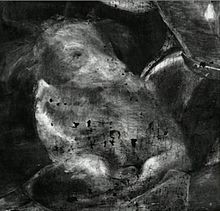art.wikisort.org - Painting
Portrait of Young Woman with Unicorn is a painting by Raphael, which art historians date c. 1505-1506. It is in the Galleria Borghese in Rome. The painting was originally oil on panel, and was transferred to canvas during conservation work in 1934. It was in the course of this work that overpainting was removed, revealing the unicorn, and removing the wheel, cloak, and palm frond that had been added by an unknown painter during the mid-17th century.[citation needed]

| Young Woman with Unicorn | |
|---|---|
 | |
| Artist | Raphael |
| Year | c. 1505-1506 |
| Type | Originally oil on panel; now on canvas |
| Dimensions | 65 cm × 51 cm (26 in × 20 in) |
| Location | Galleria Borghese, Rome |
The composition of the picture—placing the figure in a loggia opening out onto a landscape, the three-quarter length format—was apparently inspired by the Mona Lisa, painted by Leonardo between 1503 and 1506.[1] Christof Thoenes observes: "However unabashedly Raphael adopts the pose, compositional framework and spatial organization of the Leonardo portrait...the cool watchfulness in the young woman's gaze is very different" from the "enigmatic ambiguity" of Mona Lisa.[2]
The work was of uncertain attribution until recent times. In the 1760 inventory of the Gallery, the subject of the painting was identified as Saint Catherine of Alexandria and attributed to Perugino. A restoration of the painting in 1934–36 confirmed art historian Roberto Longhi's attribution of the work to Raphael, and the removal of heavy repainting revealed the unicorn, traditionally a symbol of chastity in medieval romance, in place of a Saint Catherine wheel.[1] Restoration work on the painting in 1959 revealed through radiography the image of a small dog, a symbol of conjugal fidelity, under the unicorn. It served as a sketch for the final appearance of the unicorn.[citation needed]

See also
- List of paintings by Raphael
- Giulia Farnese
Notes
References
- Barchiesi, Sofia; Minozzi, Marina (2006). The Galleria Borghese: The Masterpieces. Rome: Galleria Borghese.
- Thoenes, Christof (2012). Raphael 1483-1520: The Invention of the High Renaissance. Cologne: Taschen.
External links
 Media related to Dama con Liocorno (Raffaello Sanzio) at Wikimedia Commons
Media related to Dama con Liocorno (Raffaello Sanzio) at Wikimedia Commons
На других языках
[de] Dame mit dem Einhorn
Dame mit dem Einhorn (italienisch Ritratto di dama con liocorno) ist ein Gemälde von Raffael. Das Bild entstand zwischen 1505 und 1507[1] und wurde ursprünglich mit Ölfarben auf Holz gemalt.[1] Es befindet sich in der Galleria Borghese in Rom,[1] bis 1682 war das Bild vermutlich Teil der Sammlung Aldobrandini.[1]- [en] Young Woman with Unicorn
[es] Dama del unicornio
Retrato de una joven con unicornio o Dama con unicornio es una pintura de Rafael, fechada por los historiadores del arte en 1505 o 1506 sobre todo debido al amplio escote cuadrado de moda en esos años y también presente en otros retratos contemporáneos del maestro, como el de Maddalena Doni. Se encuentra en la Galería Borghese en Roma. La pintura originalmente un óleo sobre tabla, fue transferida a lienzo durante el trabajo de restauración y limpieza en 1934. Durante este trabajo que eliminó repintes y sobrepintes, se reveló el unicornio, y se retiró la rueda, el manto, y la palma que habían sido añadidos por un pintor desconocido a mediados del siglo XVII convirtiendo a la retratada en una Santa Catalina.[fr] La Dame à la licorne (Raphaël)
La Dame à la Licorne (en italien : Dama col liocorno) est un tableau attribué à Raphaël, datant de 1505-1506, conservé à la Galerie Borghèse à Rome.[it] Dama col liocorno
La Dama col liocorno è un dipinto a olio su tavola (65x51 cm) di Raffaello Sanzio, databile al 1505-1506 circa è conservato nella Galleria Borghese a Roma.[ru] Дама с единорогом (картина Рафаэля)
«Дама с единорогом» (итал. Dama col liocorno) — известный женский портрет кисти Рафаэля, написанный около 1505—1506 годов, произведение Высокого Ренессанса.Другой контент может иметь иную лицензию. Перед использованием материалов сайта WikiSort.org внимательно изучите правила лицензирования конкретных элементов наполнения сайта.
WikiSort.org - проект по пересортировке и дополнению контента Википедии